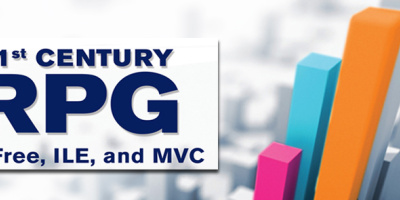In V5R1, IBM introduced the LIKEDS keyword. This keyword allows you to create a data structure that has the same set of subfields as an existing data structure. To make this happen, IBM had to create qualified data structures. I've previously talked about qualified data structures, so I won't go into those in detail.
The LIKEDS keyword allows you to clone a data structure over and over again. To take advantage of this keyword, you'll need a data structure. It can be an existing legacy data structure or it can be a new one created as a template. By "template" I mean a data structure that contains the QUALIFIED keyword and, optionally, the BASED keyword. The QUALIFIED keyword allows you to create a data structure whose subfields do not conflict with other field names, and if the BASED keyword is specified, no memory is used up by the existence of the data structure.
Along with these two keywords, you'll also need a data structure name to create a data structure template. Traditionally, a template has a unique suffix that indicates that it's a template. In the C and C++ languages, the underscore followed by the letter T (_T) is often used. For example:
D BASED(templ_ptr)
Of course, subfields need to be added, but we'll illustrate those in a minute.
In this example, the data structure named LINEITEM_T is declared. The data structure also contains the QUALIFIED keyword and BASED(templ_ptr). The BASED keyword is normally used to identify a pointer whose memory this data structure uses. If we create a dummy pointer name, as I did with templ_ptr, and then don't reference it, we effectively cause this data structure to be a template that can be used only to declare other data structures.
To declare another data structure that contains the same subfields as LINEITEM_T, we would use the LIKEDS keyword, as follows:
The new data structure named ITEMS is declared. It is a qualified data structure and includes all the subfields of the LINEITEM_T data structure. The new data structure does not inherit the BASED keyword, OCCURS, DIM, or any other data structure-level keyword. All LIKEDS data structures are implicitly qualified. In fact, the QUALIFIED keyword cannot be specified on the data structure that contains the LIKEDS keyword.
Let's look at a more complete example. Here is the data structure template again, but this time it includes the subfield definitions.
D BASED(templ_ptr)
D item 5A
D qty 7P 0
D price 7P 2
Next, I want to declare an array with the same format as this data structure template. To do this, the following code is specified:
D DIM(50)
You never access LINEITEM_T in your program, except through the LIKEDS keyword. To add data to the new ITEMS data structure array, you would use the following code.
D DIM(50)
C eval count = cgiGetVarCount('ITEM')
C for i = 1 to Count
C eval items(i).item = cgiGetVar('ITEM':i)
C eval items(i).qty = cgiGetVarInt('QTY':i)
C items(i).item Chain ItemRec
C if %Found()
C eval items(i).price = itmprice
C else
C eval items(i).price = 0
C endif
C endfor
In this example, the CGI functions included free in RPG xTools are used to extract data from an HTML Web page. Assuming an online shopping cart is used, the item and quantity ordered are retrieved, and then the item number is used to access the price. The price is then stored in the PRICE subfield of the ITEMS data structure.
Remember, you can use data structure templates over and over in the same source member, so, for example, the following is perfectly valid code:
D items_SAVE DS LikeDS(lineItem_T)
D items_UNDO DS LikeDS(lineItem_T) DIM(10)
The ITEMS data structure is used as our regular data structure array to store the data from the shopping cart. The ITEMS_SAVE data structure is used to store the current data when necessary (before altering it, for example). The ITEMS_UNDO data structure saves up to 10 instances of the ITEMS data structure so that the user can undo up to 10 actions. An UNDO function might be more applicable to an interactive/5250 application.
This is just a sample of how powerful data structure templates can be. What ways can you find to use them?
Bob Cozzi is a programmer/consultant, writer/author, and software developer of the RPG xTools, a popular add-on subprocedure library for RPG IV. His book The Modern RPG Language has been the most widely used RPG programming book for nearly two decades. He, along with others, speaks at and runs the highly-popular RPG World conference for RPG programmers.
























 More than ever, there is a demand for IT to deliver innovation. Your IBM i has been an essential part of your business operations for years. However, your organization may struggle to maintain the current system and implement new projects. The thousands of customers we've worked with and surveyed state that expectations regarding the digital footprint and vision of the company are not aligned with the current IT environment.
More than ever, there is a demand for IT to deliver innovation. Your IBM i has been an essential part of your business operations for years. However, your organization may struggle to maintain the current system and implement new projects. The thousands of customers we've worked with and surveyed state that expectations regarding the digital footprint and vision of the company are not aligned with the current IT environment. TRY the one package that solves all your document design and printing challenges on all your platforms. Produce bar code labels, electronic forms, ad hoc reports, and RFID tags – without programming! MarkMagic is the only document design and print solution that combines report writing, WYSIWYG label and forms design, and conditional printing in one integrated product. Make sure your data survives when catastrophe hits. Request your trial now! Request Now.
TRY the one package that solves all your document design and printing challenges on all your platforms. Produce bar code labels, electronic forms, ad hoc reports, and RFID tags – without programming! MarkMagic is the only document design and print solution that combines report writing, WYSIWYG label and forms design, and conditional printing in one integrated product. Make sure your data survives when catastrophe hits. Request your trial now! Request Now. Forms of ransomware has been around for over 30 years, and with more and more organizations suffering attacks each year, it continues to endure. What has made ransomware such a durable threat and what is the best way to combat it? In order to prevent ransomware, organizations must first understand how it works.
Forms of ransomware has been around for over 30 years, and with more and more organizations suffering attacks each year, it continues to endure. What has made ransomware such a durable threat and what is the best way to combat it? In order to prevent ransomware, organizations must first understand how it works. Disaster protection is vital to every business. Yet, it often consists of patched together procedures that are prone to error. From automatic backups to data encryption to media management, Robot automates the routine (yet often complex) tasks of iSeries backup and recovery, saving you time and money and making the process safer and more reliable. Automate your backups with the Robot Backup and Recovery Solution. Key features include:
Disaster protection is vital to every business. Yet, it often consists of patched together procedures that are prone to error. From automatic backups to data encryption to media management, Robot automates the routine (yet often complex) tasks of iSeries backup and recovery, saving you time and money and making the process safer and more reliable. Automate your backups with the Robot Backup and Recovery Solution. Key features include: Business users want new applications now. Market and regulatory pressures require faster application updates and delivery into production. Your IBM i developers may be approaching retirement, and you see no sure way to fill their positions with experienced developers. In addition, you may be caught between maintaining your existing applications and the uncertainty of moving to something new.
Business users want new applications now. Market and regulatory pressures require faster application updates and delivery into production. Your IBM i developers may be approaching retirement, and you see no sure way to fill their positions with experienced developers. In addition, you may be caught between maintaining your existing applications and the uncertainty of moving to something new. IT managers hoping to find new IBM i talent are discovering that the pool of experienced RPG programmers and operators or administrators with intimate knowledge of the operating system and the applications that run on it is small. This begs the question: How will you manage the platform that supports such a big part of your business? This guide offers strategies and software suggestions to help you plan IT staffing and resources and smooth the transition after your AS/400 talent retires. Read on to learn:
IT managers hoping to find new IBM i talent are discovering that the pool of experienced RPG programmers and operators or administrators with intimate knowledge of the operating system and the applications that run on it is small. This begs the question: How will you manage the platform that supports such a big part of your business? This guide offers strategies and software suggestions to help you plan IT staffing and resources and smooth the transition after your AS/400 talent retires. Read on to learn:
LATEST COMMENTS
MC Press Online